Timeless Marvels-The Magnificence of the Elephanta Caves
Elephanta Caves
The Elephanta Caves are located in Western India on Elephanta Island also known as Gharapuri, which features two hillocks separated by a narrow valley. The small island is dotted with numerous ancient archaeological remains that are rich in cultural past and situated in Mumbai Harbor, Maharashtra. These archaeological remains reveal evidence of occupation from as early as the 2nd century BC. The rock-cut Elephanta Caves were constructed about the mid-5th to 6th centuries AD. are a UNESCO World Heritage Site, declared in 1985.
The caves primarily feature Hindu religious sculptures and artwork dedicated to Lord Shiva, one of the principal deities of Hinduism. The main cave, known as the Great Cave or Cave 1, contains numerous impressive sculptures, including a notable three-headed bust of Lord Shiva known as Trimurti. This sculpture represents Shiva in three different forms: as the creator (Brahma), preserver (Vishnu), and destroyer (Maheshwara) of the universe.
Apart from the Trimurti sculpture, other notable features within the caves include various depictions of Lord Shiva, scenes from Hindu mythology, and intricate carvings that reflect the artistic and architectural prowess of ancient Indian craftsmen.
The most important among the caves is the great Cave 1, which measures 39 meters from the front entrance to the back. In plan, this cave in the western hill closely resembles Dumar Lena cave at Ellora, in India. The main body of the cave, excluding the porticos on the three open sides and the back aisle, is 27 meters square and is supported by rows of six columns each.
Geography
Elephanta Island, or Gharapuri, is about 11 km east of the Gateway of India in the Mumbai Harbour and less than 2 km west of Jawaharlal Nehru Port. The island covers about 10 km2 at high tide and about 16 km2 at low tide. Gharapuri is a small village on the south side of the island.

The island is 2.4 km in length with two hills that rise to a height of about 150 m. A narrow, deep ravine separates the two hills and runs from north to south. On the west, the hill rises gently from the sea stretches east across the ravine, and rises gradually to the extreme east to a height of 173 m. Forest growth with clusters of mango, tamarind, and karanj trees covers the hills with scattered palm trees. The foreshore is made up of sand and mud with mangrove bushes on the fringe. Landing quays sit near three small hamlets known as Set Bunder in the northwest, Mora Bunder in the northeast, and Gharapuri or Raj Bunder in the south.
Also read- ‘The Gateway of India’-Mumbai’s Iconic Landmark
The island has two groups of rock-cut caves, carved out from solid basalt rock. The larger group of caves, which consists of five caves on the western hill of the island, is well known for its Hindu sculptures. The primary cave, numbered Cave 1, is about 1.0 km up a hillside, facing the Mumbai harbor. Caves 2 through 5 are next to Cave 1 further southeast, arranged in a row. Caves 6 and 7 are about 200 m northeast of Caves 1 and 2, but geologically on the edge of the eastern hill.
There are five rock-cut caves on the western hill and a brick stupa on the eastern hill. The eastern hill has two Buddhist mounds and is called the Stupa hill. Close to the five western hill caves, are Caves 6 and 7 on the eastern hill. The most visited and significant cave is on the western hill and is called Cave 1 or the Great Cave, located about a kilometer walk up a steep graded uphill.
The rock-cut at their most elaborate, has a main chamber, two lateral chambers, courtyards, and subsidiary shrines, but not all are so fully developed. Cave 1 is the largest and is 39 meters deep from the front entrance to the back. The temple complex is primarily the abode of Shiva, depicted in widely celebrated carvings that narrate legends and theologies of Shaivism. However, the artwork reverentially displays themes from Shaktism and Vaishnavism traditions of Hinduism as well.
The two hills are connected by a walkway. The eastern hill is also called the Stupa Hill, while the western hill is called the Canon Hill, reflecting their historic colonial-era names, the ancient Stupa and the Portuguese-era firing Canons they host respectively.
The Elephanta Caves is connected by ferry services from the Gateway of India, Mumbai between 9AM and 2 PM daily, except Monday when the Caves are closed.
Elephanta caves history
The history of the Elephanta Caves is shrouded in some mystery, as the exact date of their construction and the identity of their creators remain debated among scholars. The Elephanta Caves are estimated to have been constructed between the 5th and 8th centuries AD, during the rule of various dynasties in India, including the Kalachuri, Rashtrakuta, and Chalukya dynasties. Some historians suggest that the caves were carved out during the reign of the Kalachuri dynasty (6th-7th centuries AD).
Artistic and Religious Significance-The caves are predominantly dedicated to Lord Shiva, one of the principal deities in Hinduism. The sculptures and artwork found within the caves depict various aspects of Shiva’s life, mythology, and iconography. The central sculpture in the main cave is the Trimurti, a three-headed bust representing the three primary aspects of Shiva.
The origin of the name “Elephanta” is also a subject of debate. Some believe it is derived from the Portuguese name “Elephanta” after the elephant-shaped rock found near the island. Others suggest that the name is a corruption of “Gharapuri,” meaning the city of caves in Marathi. The art and architecture of the Elephanta Caves reflect a fusion of Indian and foreign influences, suggesting a history of cultural exchange and interaction with various regions. The caves exhibit features reminiscent of Gupta and post-Gupta styles of Indian art, as well as influences from Buddhist and Jain traditions.

Abandonment and Rediscovery -The Elephanta Caves were likely abandoned sometime in the medieval period, possibly due to changes in religious practices or political instability. They remained largely neglected and overgrown until their rediscovery by the Portuguese in the 16th century. The Portuguese named the island “Elephanta” and made various attempts at restoration and preservation.
Today, the Elephanta Caves stand as a UNESCO World Heritage Site and a testament to the rich artistic and religious heritage of ancient India. They continue to attract visitors from around the world who marvel at their architectural splendor and spiritual significance.
Elephanta caves were built by
The exact builders of the Elephanta Caves remain uncertain, but historical evidence and architectural features suggest that they were likely created during the rule of various Indian dynasties, particularly during the 5th to 8th centuries AD. The caves are primarily dedicated to Lord Shiva and contain intricate sculptures and artwork associated with Hindu mythology and religious practices.
While the specific builders remain unidentified, several hypotheses have been proposed regarding the origins of the Elephanta Caves.
Kalachuri Dynasty historians attribute the construction of the Elephanta Caves to the Kalachuri dynasty, which ruled parts of central India during the 6th and 7th centuries AD. This theory is supported by stylistic and architectural similarities between the Elephanta Caves and other structures from the Kalachuri period.
Rashtrakuta Dynasty- Another proposed theory suggests that the Rashtrakuta dynasty, which ruled large parts of India from the 8th to 10th centuries AD, may have commissioned the construction of the Elephanta Caves. The Rashtrakutas were known for their patronage of art and architecture, and their influence extended across various regions of India.
Chalukya Dynasty- The Chalukya dynasty, particularly the branch known as the Western Chalukyas, is also considered a possible patron of the Elephanta Caves. The Western Chalukyas ruled parts of present-day Karnataka and Maharashtra during the 6th to 12th centuries AD and were renowned for their contributions to Indian art and architecture.
Elephanta Caves ferry timings
The ferry timings for the Elephanta Caves from the Gateway of India in Mumbai can vary depending on factors such as weather conditions, maintenance schedules, and local regulations. General information regarding the ferry timings-
Frequency- Ferries typically operate daily from the Gateway of India to Elephanta Island.
First Departure- The first ferry usually leaves early in the morning, around 9:00 AM.
Last Departure- The last ferry from Elephanta Island back to the Gateway of India typically departs around 5:30 PM.
Duration-The ferry ride takes approximately one hour each way, but this can vary depending on sea conditions.

Elephanta caves timings
The Elephanta Caves, located on Elephanta Island in Mumbai Harbor, have specific visiting hours for tourists. The general visiting hours for the Elephanta Caves are as follows-
Open Days- The Elephanta Caves are typically open to visitors every day of the week, including weekends and public holidays.
Timings- The caves are usually open from early morning until late afternoon. The opening hours for the Elephanta Caves are typically from around 9:00 AM to 5:30 PM.
It’s important to note that these timings may vary depending on factors such as season, maintenance schedules, and other operational considerations. Therefore, it’s advisable to verify the current visiting hours before planning your trip to the Elephanta Caves.
Elephanta caves tickets
To visit the Elephanta Caves, visitors typically need to purchase tickets. There is a ticket counter at the Gateway of India in Mumbai where visitors can purchase tickets for the ferry ride to Elephanta Island. The ferry ticket usually includes the entry fee to the Elephanta Caves.
The cost of tickets for the ferry ride and entry to the Elephanta Caves can vary based on factors such as nationality (foreign tourists may have different rates compared to Indian citizens), age (adults vs. children), and any additional services provided. The ticket counter generally accepts cash payments. It’s a good idea to carry local currency to purchase tickets. However, some ticket counters may accept card payments as well.
In some cases, it may be possible to book tickets for the ferry ride and Elephanta Caves entry online through official tourism websites or third-party platforms. Online booking can be convenient, especially during peak tourist seasons. Some ticket counters may offer discounts for group bookings, so it’s worth inquiring about group rates if you are traveling with a large group.
How to reach Elephanta Caves
To reach the Elephanta Caves, which are located on Elephanta Island in Mumbai Harbor, you typically need to take a ferry from the Gateway of India in Mumbai. The Gateway of India is a prominent landmark in Mumbai and serves as the starting point for ferries to Elephanta Island.
Gateway of India to Elephanta Caves
You can reach the Gateway of India by various modes of transportation, including taxis, buses, or local trains, depending on your location in Mumbai.
Once you arrive at the Gateway of India, head to the ticket counter where you can purchase tickets for the ferry ride to Elephanta Island. The ticket price usually includes the round-trip ferry ride and entry fee to the Elephanta Caves. After purchasing your tickets, proceed to the designated boarding area for the ferry to Elephanta Island. Ferries typically operate at regular intervals throughout the day, but it’s a good idea to check the schedule in advance.

Enjoy the scenic ferry ride across Mumbai Harbor as you make your way to Elephanta Island. The ferry ride takes approximately one hour each way, but this can vary depending on sea conditions. Once you arrive at Elephanta Island, disembark from the ferry and follow the signs to the entrance of the Elephanta Caves complex.
After entering the Elephanta Caves complex, you can explore the various rock-cut cave temples and sculptures dedicated to Lord Shiva. Be sure to take your time to admire the intricate artwork and historical significance of the site. After exploring the Elephanta Caves, return to the ferry terminal on Elephanta Island in time to catch the ferry back to the Gateway of India in Mumbai.



